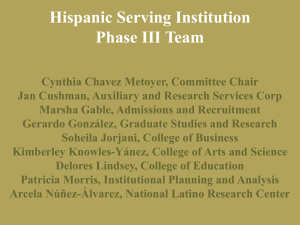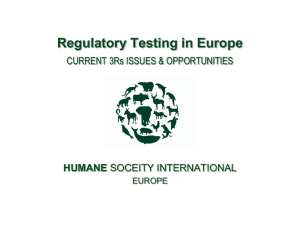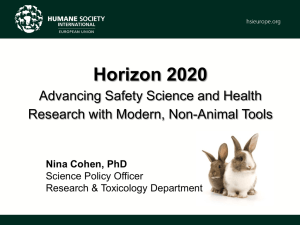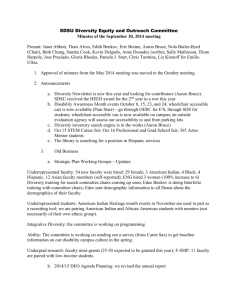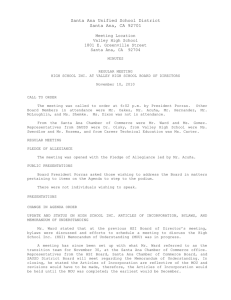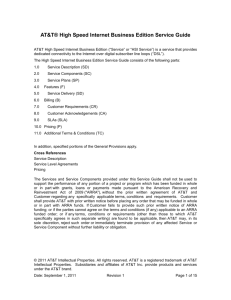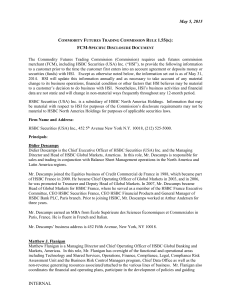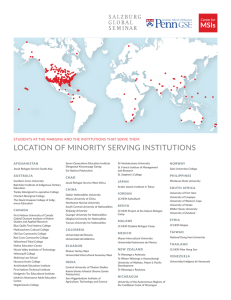Recommendations - California State University San Marcos
advertisement
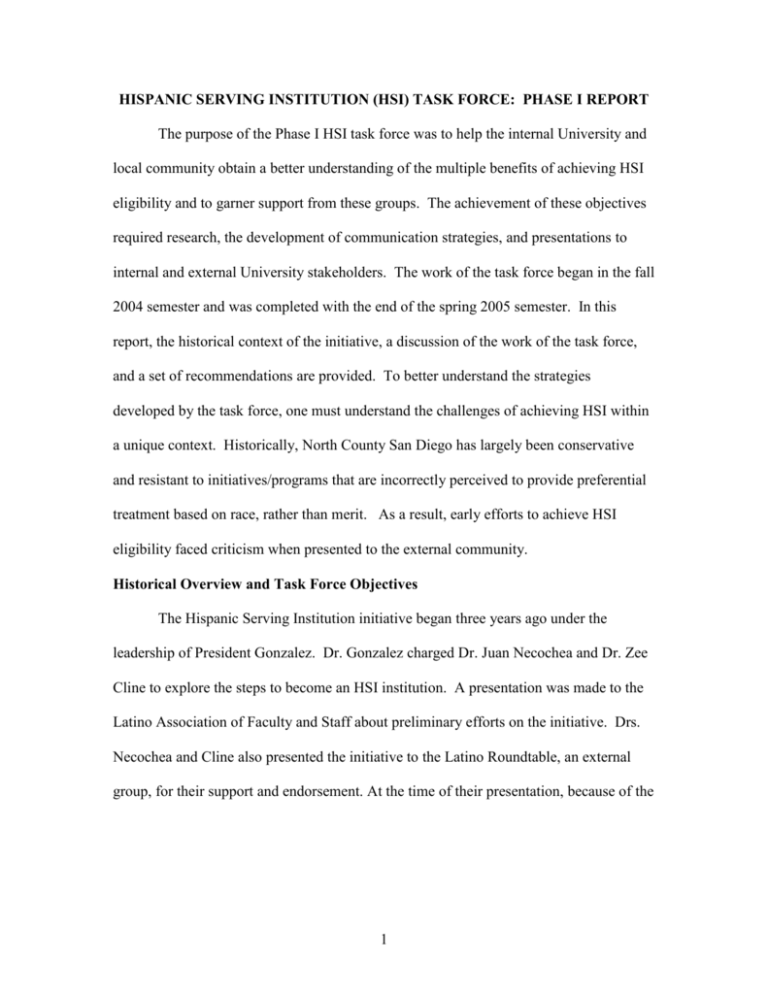
HISPANIC SERVING INSTITUTION (HSI) TASK FORCE: PHASE I REPORT The purpose of the Phase I HSI task force was to help the internal University and local community obtain a better understanding of the multiple benefits of achieving HSI eligibility and to garner support from these groups. The achievement of these objectives required research, the development of communication strategies, and presentations to internal and external University stakeholders. The work of the task force began in the fall 2004 semester and was completed with the end of the spring 2005 semester. In this report, the historical context of the initiative, a discussion of the work of the task force, and a set of recommendations are provided. To better understand the strategies developed by the task force, one must understand the challenges of achieving HSI within a unique context. Historically, North County San Diego has largely been conservative and resistant to initiatives/programs that are incorrectly perceived to provide preferential treatment based on race, rather than merit. As a result, early efforts to achieve HSI eligibility faced criticism when presented to the external community. Historical Overview and Task Force Objectives The Hispanic Serving Institution initiative began three years ago under the leadership of President Gonzalez. Dr. Gonzalez charged Dr. Juan Necochea and Dr. Zee Cline to explore the steps to become an HSI institution. A presentation was made to the Latino Association of Faculty and Staff about preliminary efforts on the initiative. Drs. Necochea and Cline also presented the initiative to the Latino Roundtable, an external group, for their support and endorsement. At the time of their presentation, because of the 1 social and political climate described earlier, 1 the initiative became controversial. A member of the media gave the initiative negative publicity by publishing a cartoon that depicted Latinos being favored by the University over other racial/ethnic groups. The University stepped back from pursing the initiative partly because of the political sensitivity of the issue. Some members of the University and local community also perceived that the President at the time may have wanted to avoid the misconception that he was favoring Latinos. Over the next few years the goal of achieving HSI eligibility faded, however, there was one group on campus who strongly believed the University should mirror the ethnic/racial composition of the local community. This initiative was very important to the Hispanic Advisory Council (HAC) who kept the goal of becoming an HSI institution as one of its top priorities. In March of 2004, the HAC convened a retreat and made a formal decision to pursue the HSI status. Some members of this group studied the mistakes of the past and strategically developed a plan to achieve HSI eligibility. Moreover, the climate on campus had changed with the appointment of a new University President who helped provide a fresh opportunity to renew an effort to achieve HSI eligibility. With the arrival of new California State University at San Marcos (CSUSM) President, Karen Haynes, HAC took the opportunity to move the initiative forward in a strategic manner. Bill de la Fuente, Chair, Edwardo Portillos, Professor of Sociology, and Lourdes Shahamiri, Vice-Chair, met with President Haynes to discuss plans to pursue 1 There are a number of other social and political issues that could help explain challenges faced by the first initiative, but the aforementioned one seems to be most directly associated to the early setback of the initiative and the one that the task force was most cognizant of as the group planned communication strategies. 2 the initiative, and to seek her guidance and approval. When the group met with Dr. Haynes, they informed her that the initiative had been endorsed by the African American Advisory Council. At the recommendation of the HAC, Dr. Haynes appointed a diverse Task Force comprised of faculty, staff, student, and administrators. Dr. Edwardo Portillos was appointed as the Chair of the HSI initiative. The task force members also included: • Karl Beeler, Associate Vice President for Enrollment Management • Gerardo González, Director, National Latino Research Center • Soheila Jorjani, Professor, Production and Operations Management • Lorena Meza, Director, Student Support Services (TRIO) and Educational Opportunity Program • Rick Moore, Director of Communications • Kathy Nguyen, Chair, Asian Pacific Islander Faculty and Staff Association • Tracey Richardson, Chair, African American Faculty and Staff Association • Edith Zarza, ASI, Inc. Individuals who provided guidance to the Communication Task Force included: • Tomás Arciniega, President Emeritus of Bakersfield • Bill de la Fuente, Chair, Hispanic Advisory Council • Lourdes Shahamiri, Vice-Chair Hispanic Advisory Council The task force began meeting in October 2004 to discuss the strategic plan to achieve HSI eligibility and brainstorm ways to implement the first phase of the plan. The following is the strategic plan, which includes three phases: The strategic plan was drawn to ensure that Phase I dealt mainly with educating the internal and external communities by communicating the benefits associated with achieving HSI status. 3 Phase II (the planning phase) will incorporate the key players to develop strategies that will achieve and maintain the required enrollment percentage of Latinos in order to qualify for full status, and make recommendations to Phase III for grant writing. Phase III will involve the HSI achieved status and grant writing development. Phase I Work In October 2004 the task force received the initial charge from President Haynes. The group met on Thursdays to discuss strategies on how best to inform campus constituencies about the Hispanic Serving Institution Initiative. The initial tasks were to become educated as much as possible about the Hispanic Serving institution designation, understand the role the Hispanic Association of Colleges and Universities (HACU) and Title V have played in achieving this designation, and investigated other campuses who have already achieved HSI status. The first meetings consisted of brainstorming, planning, and healthy discussions about how best to bring this initiative to the campus. The group agreed to separate the work into two distinct audiences: Internal and External. The primary goal was to communicate the benefits and definition of HSI to internal constituencies. The group agreed that bringing campus colleagues on board and informing them about the initiative would be critical to its success. Therefore, the group strategically identified key groups on campus. The task force began this task by first developing talking points and a PowerPoint presentation that included the history, strategies for reaching the HSI status, participants involved and the benefits to our campus. Presentations were made to the following internal groups: President’s Cabinet Associated Students Incorporated (ASI) 4 Academic Senate Executive Committee Academic Senate Academic Student Affairs Round Table President’s Enrollment Management Advisory Group President’s Executive Council Latino Association of Faculty and Staff African American Faculty & Staff Association Presentations were made to the following external groups: University Council Hispanic Advisory Council African American Advisory Council San Diego County Concilio As enthusiasm grew from presentation to presentation, Dr. Gerardo Gonzalez recommended and crafted a resolution and presented it to the Academic Senate. With minor modifications the resolution was unanimously passed. The task force student representative, Edith Zarza and task force Chair, Dr. Eddie Portillos, made a presentation to ASI which resulted in a resolution of endorsement. At every presentation, there was strong support as people began to understand the scope of the benefits to the campus. Next, the task force strategized about presenting the initiative to the external community. The group agreed that a brochure noting the talking points with a catchy title of “Preparing for Greater Diversity” would be beneficial. This brochure would include how HSI status will benefit everyone, the definition of HSI, specific benefits to the campus, what HSI has meant for other campuses, eligibility criteria, what the campus 5 has done to prepare, and support from the campus President. The task force agreed that this brochure would further demystify the HSI designation and benefits (see attachment A). A further external communication strategy was the development of a website to provide information about the initiative. This website would also include ongoing reports from the task force, links to other campuses that have achieved the HSI status, and additional information about Title V and HACU. The final communication strategy was crafting a press release. The task force agreed that it was necessary to be prepared for the media. The press release included the talking points and benefits of HSI, and was first published in TRACKS, the campus newsletter. Recommendations The Phase I of the communication task force has been completed. The task force has several recommendations for Phase II efforts. The task force offers these as recommendations and realizes that Phase II members may decide to keep some or all of the suggestions for future work. The group recommends that external communication should be a priority for Phase II of the task force. Phase I task force came to the conclusion that presentations to various external groups should go hand in hand in with recruitment and retention efforts. The group believes the opportunity to communicate CSUSM HSI efforts to the external community is also an opportunity to recruit Latino students. In addition, these communication efforts could lead to a collaborative partnership with the local community where strategies are developed to increase the number of Latino students on campus. For example, there are conferences attended by counselors and the task force could present at these meetings and later meet with 6 interested school personnel. The objective of these meetings could be to further develop strategies and recommendations to increase the percentage of students of color at CSUSM. During these presentations communication efforts should strive to stress the multiple benefits of achieving HSI eligibility, including as an enhancing existing diversity of the campus by providing the necessary institutional resources to help students succeed at the University. Another communication effort and potential recruitment tool is to ensure that CSUSM is profiled in the Hobsons’/HACU marketing guides. Through the task force communication efforts with CSUSM administrators, faculty and staff, as well as representatives from the community and surrounding community colleges, the group heard suggestions to strengthen the pipeline from high school, to community colleges and to CSUSM. Although there are existing programs such as Advancement Via Individual Determination (AVID), which have had remarkable success, there is a need for larger and systemic efforts to reach qualified high school and community college students who could attend CSUSM. In fact, data provided from Bettina Huber in Analytic Studies show there are 30% Latino students graduating from San Diego County high schools. Moreover, Latinos account for about 23% of the students at MiraCosta and Palomar College, however, some of these students do not go on to enroll at CSUSM. A review of the data indicates that we are currently at 21% Latino students. Phase II activities should aim to develop strategies to reach and maintain the 25% needed to attain HSI eligibility. This could include exploring how students report their ethnic identity and determining whether a significant number of Latino students identify themselves as “other.” Therefore, second year work could include investigating the 7 possibility of having a pop up feature on the CSU Mentor that would inform students of the value of identifying their ethnic/racial identity. The task force also recommends that Phase II work begin in the fall 2005 semester and continue with both existing and new members. The group recommends Gerardo González as the new chair of the Phase II task force. In addition, the group recommends current member Lorena Meza be involved. As the director of SSS and EOP she has important insights concerning the needs of the Latino student population on campus. Moreover, the task force recommends that new member Carolina Cárdenas from University Outreach and Recruitment be involved since she is already experienced in writing grants and one of the key administrators who develops and implements recruiting strategies. In addition, group recommends new member Bettina Huber, Director of Analytic Studies, be involved as well to help the task force monitor the group progress towards achieving HSI eligibility through bi-annual updates and offer suggestions and advice based on an analysis of available data. Also, Glen Brodowsky, COBA faculty member, offered to be involved with the marketing strategy. The task force further recommends that current member Soheila Jorjani, College of Business Administration faculty member, participates in the second phase as the representative of the College of Business and as the webmaster of the HSI website. Current member Edith Zarza has also expressed an interest to participate in the second phase as a community representative and Madeline Aragon has volunteered to be the ASI student representative. Other key individuals that should be included in the second phase are current member Tracey Richardson as a representative of the African American Advisory Council and active member of the first phase of the task force. Also, current 8 task force advisors Lourdes Shahamiri and Bill de la Fuente should participate in the second phase because they have shaped early efforts and were eager participants of the Phase I communication task force. New members Susan Mitchell, Associate Vice President Student Academic Support Services, Jorge Riquelme, College of Arts and Sciences faculty member, and David Barsky, Interim Director, First-Year Programs should also be on the Phase II task force. These members would form the core group of the Phase II HSI task force initiative and then they could strategically choose other key members who could help contribute to the overarching goal of achieving HSI eligibility by 2010. The task force feels that the President of the University should appoint these members to Phase II work to demonstrate University commitment to achieving HSI eligibility. In addition to the task force members, the group suggests there be an advisory group whose membership would include local educational leaders (i.e., superintendents, principals, counselors, community leaders) and University officials, administrators and faculty. Potential members of the advisory group include Tomás Arciniega, President Emeritus of Bakersfield, Nathan Evans, Director of Admissions, Daren Bush, Associate Vice President for Enrollment Management, Juan Necochea, College of Education faculty member, Victor Rocha, Director of Biomedical Research and Training, and Rick Moore, Director of Communications. The advisory group should meet periodically with task force members and further advise and suggest strategies in which to reach the task force goals. The second phase should also begin conversations with the North County Higher Education Alliance (NCHEA) and apply for funds through this organization to support 9 some of the recruitment and retention strategies developed by the task force. Grants through NCHEA could be used to help establish articulation agreements and solidify strategies to strengthen the educational pipeline for students from the community colleges to CSUSM. Finally, the work of the Phase II task force should ensure that the goal of achieving HSI eligibility is embodied in the University Strategic Plan. The task force believes that the goal of achieving HSI has to be in the strategic plan to illustrate that it is an institutional priority and would demonstrate the University’s commitment to achieve this goal. Moreover, achieving HSI eligibility will help meet the University’s strategic priorities which include campus climate, community partnership, academic excellence, student life, and educational equity. 10
